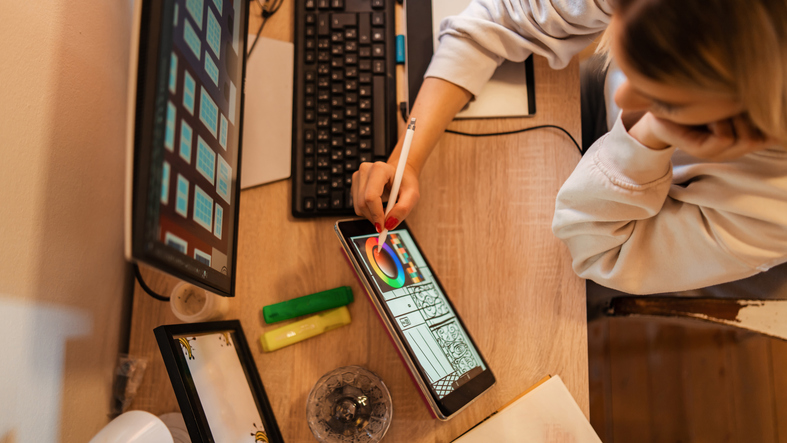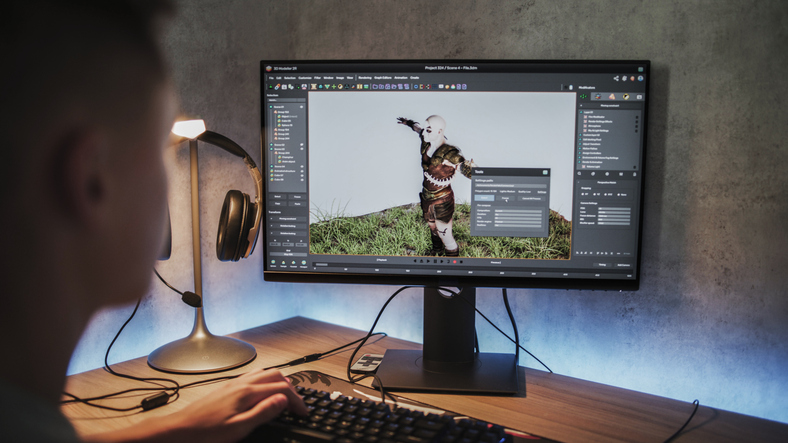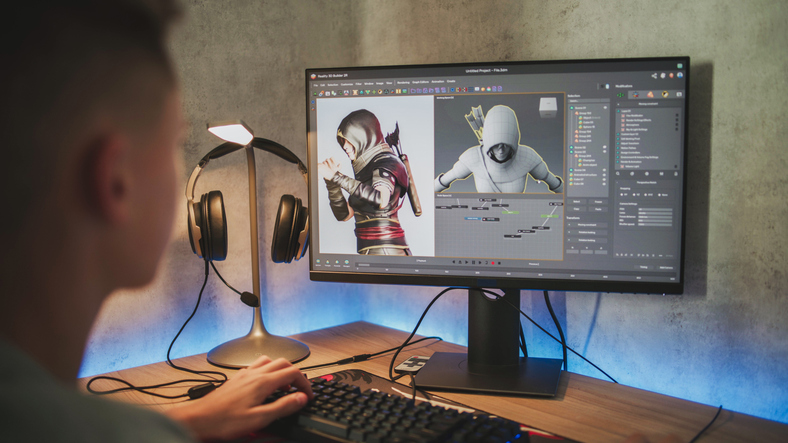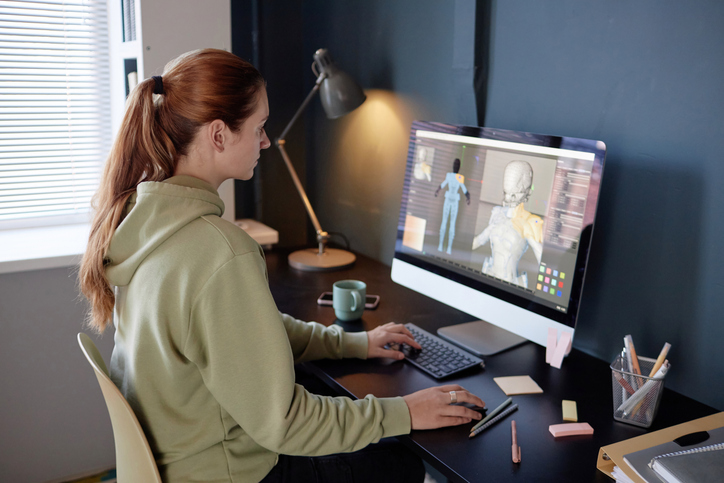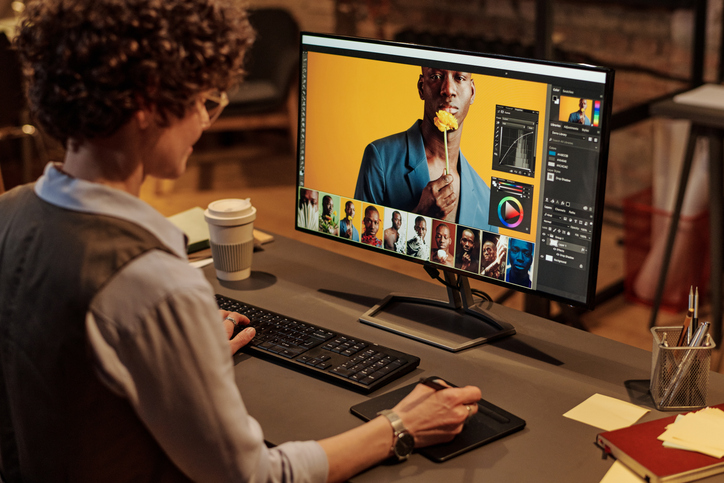Design shapes our daily experiences from the products we buy and the websites we visit to the apps we cannot live without. Yet, when exploring careers in design, prospective students often find themselves navigating the blurry lines between Graphic Design and UX/UI Design. While both fields prioritize visual appeal and user engagement, they each offer unique challenges, opportunities, and rewards. This blog will unravel the difference between Graphic Design and UX/UI Design, highlighting the roles, responsibilities, required skills, and pathways for transitioning between them. We will also explore why VCAD's Graphic Design program can set you on a vibrant career path.
Understanding Graphic Design
Graphic design is the art of visual storytelling. It uses imagery, typography, colour, and layout to communicate clear, engaging messages. Whether through digital or print media, graphic design helps brands and organizations visually connect with their audience.
What is Graphic Design?
At its core, graphic design is visual communication. Graphic designers craft visually compelling messages designed to inform, persuade, and captivate audiences. From digital platforms such as websites, apps, social media graphics, and digital ads, to traditional formats like posters, billboards, magazines, books, and product packaging, graphic design influences every aspect of our daily lives.
Graphic design is an essential element in shaping the identity and perception of businesses, products, and services. It uses a thoughtful combination of creativity, aesthetics, and strategic thinking to effectively communicate specific messages, convey emotions, and strengthen brand identities. Every visual element, from the choice of colours and typography to the arrangement of images and text is meticulously planned to engage and resonate with the target audience.
Furthermore, graphic design is dynamic and constantly evolving with technological advancements and shifts in consumer preferences. Today's graphic designers must stay adaptable, continuously updating their skills to meet industry trends and client expectations. This vibrant and versatile field is ideal for individuals who thrive in creative environments, enjoy bringing concepts to life visually, and appreciate the powerful role design plays in shaping how we interact with the world around us.
Graphic designers play crucial roles across numerous industries, including advertising, publishing, marketing, and branding. Typical responsibilities include:
- Creating logos and visual branding materials, ensuring consistency and visual coherence across various platforms.
- Designing marketing materials like brochures, posters, flyers, business cards, and advertisements to effectively capture the attention of targeted audiences.
- Crafting digital graphics for websites, social media, digital ads, email campaigns, and mobile applications to engage online audiences.
- Preparing designs for print production, managing technical requirements such as resolution, color accuracy, and formatting standards.
- Working collaboratively with clients, marketers, copywriters, web developers, and art directors to understand their vision, interpret their needs, and deliver designs that meet business goals.
- Staying updated with industry trends, design innovations, and new techniques to deliver fresh and relevant content.
Skills Required for Graphic design
Graphic design is perfect for individuals with a flair for creativity and a keen eye for detail. Essential skills include:
- Proficiency in design principles such as colour theory, typography, composition, hierarchy, balance, alignment, and contrast to create visually pleasing designs.
- Mastery of industry-standard design software, primarily Adobe Illustrator, Photoshop, and InDesign, as well as familiarity with emerging digital tools.
- Ability to interpret client briefs, understand project objectives, and transform ideas into impactful visual concepts that meet business and audience goals.
- Persuasive communication skills for effectively presenting design concepts, receiving constructive feedback, and collaborating with multidisciplinary teams.
- Understanding branding and marketing concepts to ensure designs not only look appealing but also strategically resonate with target audiences and support overarching business objectives.
- Attention to detail and the ability to work methodically under tight deadlines, managing multiple projects simultaneously without compromising quality.
Bonus Read: AI in Graphic Design: The Future of Graphic Designers
Exploring UX/UI Design
UX (User Experience) and UI (User Interface) design form the backbone of digital products, ensuring they are intuitive, accessible, and visually appealing. UX/UI design prioritizes both aesthetics and practical functionality, enhancing how users interact with digital products.
What is UX/UI Design?
User Experience (UX) design is a user-centered approach to product creation, aiming to provide meaningful, seamless, and satisfying experiences. UX design includes researching user needs, mapping user journeys, structuring information logically, and ensuring product functionality aligns with user expectations.
User Interface (UI) design complements UX by focusing specifically on a product’s visual and interactive components. UI designers create visually attractive interfaces that guide user interactions through clear and engaging layouts. They ensure every visual element contributes to the ease of navigation and accessibility, enhancing overall user satisfaction.
Together, UX/UI design significantly influences product success by creating intuitive, enjoyable, and engaging digital experiences.
Roles and Responsibilities of UX/UI designers
UX/UI designers have distinct yet complementary roles:
UX Designer Responsibilities:
- Conduct extensive user research to understand behaviours, motivations, and pain points.
- Develop detailed user personas and journey maps to visualize the user experience.
- Create wireframes and interactive prototypes to define product functionalities clearly.
- Conduct usability tests and analyze feedback to continuously refine user experience.
- Work collaboratively with product managers, developers, marketers, and other stakeholders to ensure user-centric design solutions.
UI Designer Responsibilities:
- Design intuitive, attractive interface elements such as buttons, menus, icons, sliders, and forms.
- Select appropriate colour schemes, typography, and graphic layouts that enhance readability and visual appeal.
- Develop high-fidelity mockups and prototypes for stakeholder reviews and testing.
- Ensure consistency in visual design across different screens and interactions.
- Collaborate closely with developers during the implementation phase to ensure accurate translation from design to final product.
- Maintain design consistency and usability across various devices and screen sizes.
Skills Required for UX/UI design
Success in UX/UI design requires diverse, interconnected skill sets, including:
- Technical Proficiency: Mastery of prototyping and design tools such as Sketch, Figma, Adobe XD, and InVision.
- Analytical Thinking: Ability to analyze user data and translate findings into actionable design solutions.
- Creativity and Visual Sense: Strong aesthetic judgment and ability to create visually pleasing designs aligned with brand guidelines.
- Communication and Collaboration: Exceptional skills in presenting designs, receiving constructive feedback, and effectively working within cross-functional teams.
- Empathy: Deep understanding and consideration of user perspectives and emotions to enhance user satisfaction.
- Coding Knowledge: Basic understanding of HTML and CSS can help UI designers ensure smooth implementation and collaboration with developers.
Key Differences Between Graphic Design and UX/UI Design
Graphic Design and UX/UI Design are interconnected yet distinct disciplines within the creative industry, each serving unique purposes and requiring specific skill sets. Understanding these differences can help individuals determine the right career path or identify which expertise best fits their project needs.
1. Core Objectives
-
Graphic Design is primarily about visual storytelling and communication. It focuses on creating compelling visuals that inform, persuade, and engage audiences, primarily through aesthetics and strategic visual arrangement.
-
UX/UI Design, however, centers on user interaction and satisfaction. UX (User Experience) emphasizes functional and intuitive user journeys, while UI (User Interface) ensures interfaces are visually appealing and easy to navigate.
2. Focus and Approach
-
Graphic Designers prioritize visual aesthetics, brand identity, and creative expression. They meticulously plan visual elements like imagery, typography, colour, and layout to deliver impactful messages.
-
UX Designers focus on user-centric experiences, including user research, usability testing, and user journey mapping to optimize functionality and satisfaction.
-
UI Designers bridge UX insights with visual design, crafting interactive, intuitive, and visually appealing interfaces for digital products.
3. Tools and Technologies
-
Graphic Designers primarily use Adobe Illustrator, Photoshop, and InDesign, along with print-focused tools to manage visual consistency and quality across various media.
-
UX/UI Designers commonly utilize digital prototyping and design software like Sketch, Figma, Adobe XD, and InVision, facilitating interaction design, prototyping, and collaboration with developers.
4. Roles and Responsibilities
-
Graphic Designers are responsible for visual branding materials, marketing collateral, digital graphics, and ensuring consistency across multiple platforms.
-
UX Designers perform user research, create wireframes and prototypes, conduct usability tests, and ensure a seamless user journey.
-
UI Designers design interface elements such as buttons, icons, and layouts, ensuring visual and interactive consistency, and collaborate closely with developers for accurate implementation.
5. Skill Sets
-
Graphic Design requires strong creative skills, proficiency in design principles, mastery of graphic design software, and strategic visual communication.
-
UX/UI Design demands a combination of analytical thinking, empathy, technical proficiency in digital tools, understanding of user psychology, interactive prototyping, and collaboration skills. Basic knowledge of coding languages like HTML and CSS can be beneficial for UI designers.
6. Output and Medium
-
Graphic Designers often create outputs for both print and digital formats such as posters, brochures, magazines, advertisements, and web graphics.
-
UX/UI Designers exclusively design digital experiences like websites, mobile apps, and software applications, focusing on interactivity and usability.
By recognizing these differences, creative professionals and businesses can more effectively leverage these roles to achieve cohesive visual identities and engaging user experiences.
Transitioning Between Graphic Design and UX/UI
Graphic designers often find UX/UI appealing because it leverages their existing design strengths while introducing new challenges related to interactivity and user engagement. Transitioning from graphic design to UX/UI is feasible, particularly because many core skills transfer seamlessly.
Graphic designers possess valuable foundations in visual hierarchy, typography, and layout skills crucial to UI design. However, transitioning successfully requires additional learning in user-centric design principles, interactive prototyping, and user testing methods.
Steps for a smooth transition include:
- Enrolling in specialized courses to gain practical experience.
- Building a UX/UI portfolio with projects demonstrating a strong understanding of user-centered design.
- Networking with professionals already working in UX/UI to gain industry insights and mentorship.
Why Choose VCAD's Graphic Design Program?
VCAD’s Graphic Design program is specifically crafted for creative individuals eager to combine artistic talents with industry-ready skills. Here’s why VCAD is the ideal choice:
Flexible Online Learning: Study at your pace from anywhere, providing the freedom to balance learning with personal commitments.
Comprehensive Curriculum: VCAD offers a robust curriculum that covers essential graphic design skills, including:
- Drawing, illustrating, and digital colouring
- Typography mastery
- Digital photography
- Packaging and corporate design
- Advertising and complete website design
Industry-Relevant Skills: Guided by experienced industry experts, you will learn using professional-grade software such as Adobe Illustrator, Photoshop, and InDesign. The program culminates in a professional portfolio displaying your best work, positioning you to impress future employers.
Career Opportunities: Upon graduation, a wide range of rewarding careers await you, including:
- Graphic Designer
- Illustrator
- Web Designer
- Layout Designer
- Ad Designer
- Page Designer
- Graphic Artist
The program is certified by the Registrar of the Private Training Institutions Regulatory Unit (PTIRU) of the Ministry of Post-Secondary Education and Future Skills, ensuring a recognized and quality education.
Start Your Graphic Design Journey Today
Whether your passion lies in branding, digital media, advertising, or beyond, VCAD's Graphic Design program provides a solid foundation and hands-on experience necessary to excel. The skills gained are not only industry-relevant but also versatile, opening doors to numerous creative careers.
Explore the vibrant world of graphic design, leverage your creativity, and start building the career you have always envisioned with VCAD. Your journey towards an exciting design career begins today!
